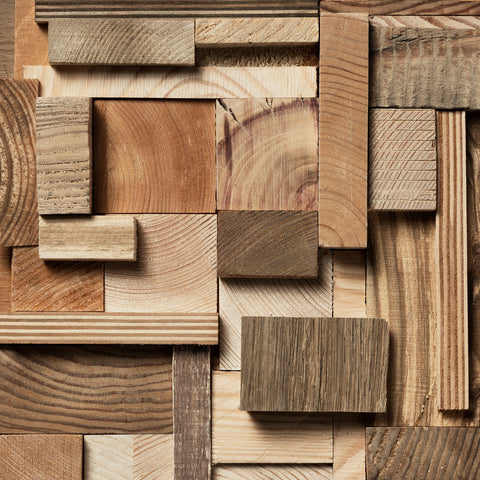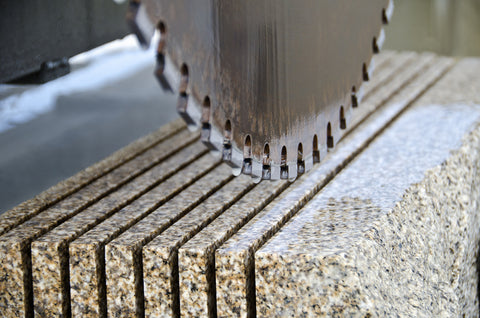How do you know which saw blades are best for which materials?
When selecting a saw blade, the first and foremost distinction is the material you’ll be cutting. Cutting through wood is obviously much different than glass or steel.
You can use the same circular saw for multiple jobs by simply switching out the blade. But which blades do you need in your blade-box?
In this article, we’ll go through the basic blade types that work best for the different materials you’ll likely come across on the job. Keep in mind that each of these blades also has variations based on the type of cut, the project, the speed, and other factors.
Below are the types of materials (in the order we’ll discuss their associated blades):
- Lumber wood (hardwood and softwood)
- Plywood
- Laminate
- Plastic
- Acrylic
- Plexiglas
- Natural stone
- Concrete
- Ceramic and other tiles
- Steel
- Aluminum and metal
1. Wood cutting blades
A variety of woods call for a variety of cuts. There are three types of basic wood blades that we switch through, not only because of the material and thickness of the wood but also the type of cutting (straight edge versus joint).

Construction blades are made for fine cutting of lumber wood. They have usually around 40 or more teeth. They have deep gullets in between the teeth to remove chips and sawdust during the cutting process. They’re either high speed steel or carbide tipped depending on your budget and needs. They’re sometimes referred to as “carbide tipped saw blades.” These blades cut in a counterclockwise direction, so you typically want to cut from the backside of the board to get a smooth cut.
Plywood blades have more, smaller teeth, often numbering up to 160 teeth per blade. This allows for a cleaner and smoother cut while generating less dust. Because the teeth are so close together, more of the blade touches the wood at once so it can cut straighter. Plywood blades are usually made of high speed steel and can come coated or uncoated. These work for wood materials no more than 3/4 inch thick, like plywood and laminate.
Dado blades are used to make grooves, dadoes, and rabbet cuts in lumber. It’s a circular blade that can make groove cuts of various widths, so you can fit wood pieces together to create a joint. These are usually adjustable depending on the size of the chip and grooves.
Crosscutting blades are used to cut across the wood grain at a right angle. These typically have more teeth and a smaller gullet (area between the teeth) to create a smoother cut. These work best for finishing work that needs a smoother, more finished edge. Crosscut blades cut like a knife. Hollow ground blades are a type of crosscutting blade that makes smooth, careful cuts across wood.
Ripping blades cut parallel to the wood grain to create a deeper cut. These tend to have fewer teeth and large gullets, so they’re best for general carpentry work. The front edges of the teeth are flat without an angle, which allows for a straight cut along grain lines. Rip blades cut like a chisel.
Combination blades, also referred to as “all-purpose blades,” can both rip and crosscut wood. They’re highly versatile for a variety of woodworking applications, so we recommend them for every professional’s blade-box.
2. Plastic cutting blades
Plastic cutting blades, also called “acrylic cutting blades,” are similar to wood cutting blades, but they typically have more teeth. Wood blades average around 40 teeth while plastic blades have around 60. They cut through plastic, acrylic, and soft, non-ferrous metals. For Plexiglas, you’ll want a fine blade with at least 80 teeth.
Tip: Cut into plastic and soft materials slowly. If you go too quickly, the material can “catch” on the saw blade, which can damage both the blade and the project. You’ll want to cut with a smooth, pushing motion.
3. Masonry cutting blades
Masonry cutting blades, also called “abrasive blades,” are used to cut stone materials. These blades are usually toothless, so more of the blade touches the stone for a stronger cut. They’re usually made of fiberglass-reinforced silicone carbide. (This is the same material commonly used in sandpaper.)

There are two main types of stone blades based on the density of the stone being cut.
Coarse masonry blades are made for softer materials like concrete blocks, bricks, and limestone.
Diamond blades cut concrete, marble, granite, ceramic, and glass materials. These are usually the strongest types of blades.
Tip: When cutting through stone blocks, you’ll want to start with a scoring cut that’s about 1/4 inch deep. Then, tap a cold chisel along the cut. This usually splits the material along the scored line for a smoother, easier cut.
4. Metal cutting blades
Metal cutting blades are usually toothless to create a smooth cut through strong metal. They often have heat expansion slits to help dissipate heat while cutting into heat-conducting materials (like metal). Most metal cutting blades are versatile and can cut both ferrous and non-ferrous materials like brass, bronze, copper, aluminum, and light-gauge steel.
You might want to purchase a separate steel cutting saw blade specific for cutting steel. These are carbide grade, so they resist breakage, and they tend to last longer than other metal cutting discs.
5. Panel saw blades
There are specific blades made for cutting “panels” of materials. These are used to create larger boards or sheets, like for cabinets and signs. These blades can cut through melamine, plywood, aluminum, plastic, wood, laminates, and veneer. They typically cut through thinner layers, up to 3/4 inch.
Often, you’ll want to cut the material down using another type of material-specific blade. Then, you can use a panel saw blade to cut it into the shape of the sheet you need.
6. Demolition saw blades
Demolition saw blades are made for “demolition.” They cut through most materials, especially stronger and more durable ones. They create harsh, rough cuts, so they work well for fast cutting that doesn’t require a smooth or finished edge. These can cut through just about anything including roofing, shingles, nails, and non-ferrous materials.
Note about kerf
The “kerf” refers to the thickness of the blade. The thickness will determine the blade’s ability to cut through certain materials. It will also determine how it cuts through the material.
The thicker the blade or “kerf,” the more you can sharpen the blade. This means you can typically get more use and longer lifespan of thick kerf blades. However, thick kerf blades tend to create a harsher cut. These work well for high-powered saws for larger carpentry projects.
Thin kerf blades are sharper and cut faster. They also require less work from the saw because they cut less wood at once. It also wastes less of the material being cut, which saves you money in the long run. These work best for low-powered saws and detail work.
When selecting your blade, you’ll want to look at the teeth and kerf.
Conclusion
Your circular saw blade can be the most versatile tool you own if you use a variety of saw blade types. You’ll want to select your blade type based first and foremost on the material you’re cutting as well as the type of cut you want to create.
Not sure which blades are right for your saw and projects?
Contact Ryker Hardware now for a consult about your cutting project.

Is there a multipupose blade out there to cut glass and aluminum mosaic tile ??
Leave a comment